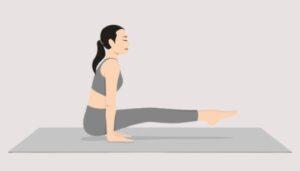Exploring Koormasana: The Tortoise Pose
Every asana in the yoga arena has a distinct purpose and can provide a combination of bodily advantages, mental peace, and spiritual awakening. One of these poses is called Koormasana, or the Tortoise Pose. Its name, which comes from the Sanskrit words “Koorma” (which means tortoise) and “asana” (which means pose), is deeply symbolic and offers numerous physical and mental benefits.
Steps Perform to Tortoise Pose (Koormasana):
Sit in Dandasana (Staff Pose): Seated on the floor with your legs extended in front of you, start now. Make sure your hands are lying next to your hips and your spine is straight.
Bend Your Knees: As you slowly pull your feet closer to your hips, bow your knees. Throughout the position, keep your feet and knees together.
Lower Your Torso: Lower your torso to the ground by gently leaning back. Keep your chest raised and your spine in proper alignment when you perform this.
Thread Your Arms: With your hands facing up, slide your arms beneath your thighs. Reach as far as your arms will comfortably go, trying to draw them in closer to your ankles.
Position Your Chin: Bring your chin up to your chest so that your forehead is in closer contact with the floor. Keep your neck loose during the entire position.
Hold the Pose: Hold this pose for 30 to 1 minute, concentrating on taking deep breaths and allowing yourself to be fully in the pose.
Release: To come out of Dandasana, gently bring your chest back up, straighten your legs, and release your arms from below your thighs.
Benefits of Tortoise Pose (Koormasana):
Improved Spinal Flexibility: By extensively stretching the spine, Koormasana reduces back strain and enhances spinal flexibility.
Hip Opening: This posture stretches the inner thighs, groin, and hips to increase flexibility and relieve stiffness in these regions.
Stress Reduction: Koormasana’s reflective and peaceful atmosphere promotes relaxation and tranquillity by lowering tension and anxiety.
Digestive Health: Koormasana improves digestion and relieves bloating or discomfort by compressing the abdomen, and stimulating the digestive organs.
Energy Flow: By regulating the flow of energy throughout the body, this pose helps maintain balance and vigor.
Precautions and Contraindications of Tortoise Pose (Koormasana)
Avoid Overexertion: As with any yoga practice, pay attention to your body and don’t push yourself over your comfort zone. Be mindful of your body’s limits and take it to slow when assuming the pose.
Injuries: Before attempting Koormasana, people with chronic diseases or injuries affecting the knees, hips, or spine should exercise caution or speak with a skilled yoga instructor or healthcare provider.
Pregnancy: To safeguard the safety of both mother and child, pregnant women should adjust or avoid positions like Koormasana that involve deep abdominal compression.
Neck Sensitivity: Refrain from lowering your chin too near to your chest in the position if you feel pain or tension in your neck. Remain calm and only extend your neck as far as it is comfortable.
the Tortoise Pose, or Koormasana, represents the virtues of resignation, patience, and contemplation. With its mild yet deep stretches, it provides a haven for the body and mind to relax, restore, and achieve balance. Remember to approach this pose mindfully, respecting the knowledge of your body and welcoming the path toward overall well-being as you practice it.
Read More: Yoga in Rishikesh
Learn to know more About Yoga Poses So You Can visit best yoga school and join 200 hour yoga teacher training in rishikesh and yin yoga teacher training in india




